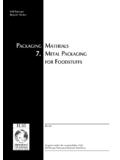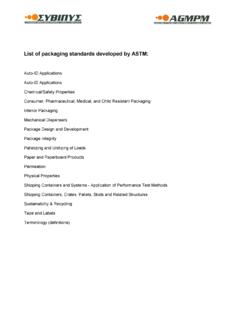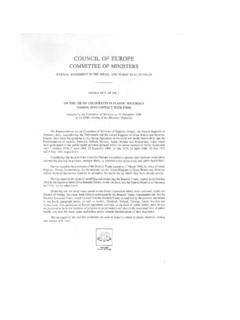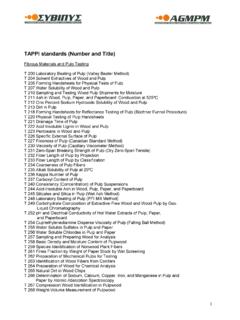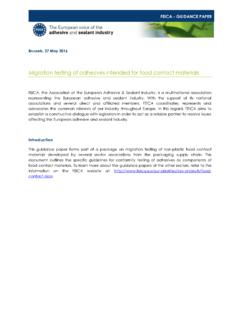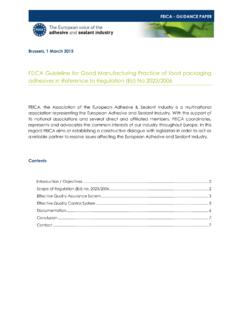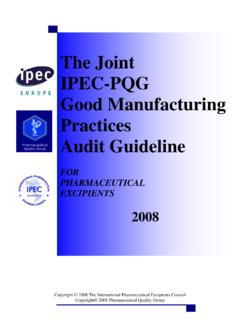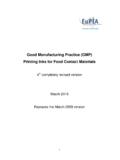Transcription of Good Manufacturing Practice Guide - pac.gr
1 good ManufacturingPractice Guide labelsFor the printing of labels and related packaging for the food, drinks and sensitive product sectorsP a g e| 1 good Manufacturing Practice Guide For the printing of labels and related packaging for the food, drinks and sensitive product sectors. A management tool for the minimisation of migration, organoleptic changes and contamination. Issue No. 1 Published January 2013 This good Manufacturing Guide was developed at the initiative of BPIF labels. BPIF labels would like to give special thanks to ECMA and BPIF cartons for allowing them to use their GMP as a template for the GMP for the label industry. The content covered in the present publication is within the industry recognised as the core public European GMP reference for labels and related packaging. The working party responsible for producing this Guide : John Bambery (Chairman BPIF labels), Ian Lemon ( Springfield Solutions), Spencer Johnson (Chesapeake), John Hill (Herma), Patrick Eagle (HP Indigo), Allan Lewis (Domino),Clive Sturridge (Colorgen), Michael Simoni (Sun Chemical), Paul Regan (Zeller + Gmelin) Note to the reader This is the first version of the BPIF labels GMP Remarks and suggestions for improvement to future publications are most welcome.
2 Disclaimer This document is intended as guidance and information only. It is the responsibility of the users of this document to assess the suitability and relevance of the guidance and information for their products and operations and the document is not a substitute for obtaining appropriate expert advice. BPIF labels and the member of the working party (both personally and the organisations they represent) accept no liability whatsoever for any decisions or actions based on the contents of this document. These remain the sole responsibility of the users of the guidance and information. Contents 1 Introduction and Objectives .. 3 Scope and introduction .. 3 Objectives .. 3 Legislation .. 4 2 Regulations, recommendations and guidance documents .. 6 Introduction .. 6 Horizontal legislation in the EU .. 6 Horizontal guidance documents.
3 7 Material specific legislation and guidance documents .. 8 Mutual recognition of national laws .. 13 Exports Outside the European Union .. 14 Import from countries not being a member of the EU .. 14 3 Migration .. 15 Types of Migration .. 15 Sources of contamination .. 16 Migration influencing parameters .. 16 Food contamination .. 16 4 Recommendations for GMP Compliance .. 17 Key Actions for the Converter .. 17 Commitment and Responsibilities .. 17 Purchasing .. 18 Design Specification .. 18 Product Development and Performance .. 20 Relevant Control 21 Goods In and Out and Storage .. 22 Traceability .. 22 Quality Checks .. 23 Training .. 23 Hygiene .. 23 Hazard Analysis .. 24 Testing .. 25 Evidence supplied by Material Suppliers .. 28 Statement of composition .. 29 5 Guidance on Inks and Varnishes.
4 30 Introduction .. 30 Ultra-Violet Cured (UV) Inks and Varnishes .. 30 Conventional inks and water-based inks and overprint varnishes .. 31 Digital inks and toners .. 31 Printing additives and fount solutions.. 31 Ink Mixing and Colour Matching .. 31 Cleaning .. 31 Ink Drying .. 32 Ink Film Weight .. 32 Control .. 32 Changing from Normal to Low-Migration Printing .. 33 6 Process Flow (A typical flow chart) .. 34 7 References used .. 35 8 Abbreviations, Definitions and Glossary .. 37 9 Questions & Answers .. 41 10 Compliance statement with BPIF labels GMP Guide .. 45 11 Document 46 Statement of Composition .. 46 EuPIA Guideline on Printing inks applied to the non-food contact surface of food packaging materials and articles .. 46 P a g e| 3 1 Introduction and Objectives Scope and introduction This Guide is developed for companies which manufacture labels and related packaging products, intended to come into contact with food, or that could be brought into contact with food, or that could be the source of chemical migration into food.
5 This GMP is an information and management tool with methods that can be adopted by converters and audited through proper implementation. It focuses on the design, development and specification stages in the Manufacturing process of packaging products. It should be implemented by converters who employ an effective, independently audited, quality management (QM) system. It must be embedded in a system such as ISO 9001. It is not to be used as a standalone document. Before adoption, your technical processes must be organized to reliably produce only labels and related packaging that conform to specifications. You will also need a complete system for hygienic control, EN 15593/ ISO 22000 (or equivalent such as BRC/IOP). GMP design for compliance is the short-term description of the best approach. The choice of raw materials and production methods must be such that the products match entirely with the goals of this GMP.
6 Traceability and certification of raw materials are also important. Certified compliance with legislation and conformity with the highest standards is recommended for the raw materials. This certification must be based on an independently audited QM system of the supplier s Manufacturing process. This code gives guidance and information that will enable the converter to ensure that, under specified and controlled circumstances, packaging will not give rise to non-compliant migration, organoleptic changes or contamination. This can however not be achieved through appropriate materials and production techniques alone. The customer must contribute to compliance by giving appropriate information and by only using the packaging for the purpose originally designed and intended. This GMP supports the information provided in the European Food Contact Legislation.
7 Any National legislation, standards, recommendations or guidelines from local authoritative bodies should also be followed as part of successful implementation of the GMP. Objectives In line with Article 3 of Regulation (EC) No 1935/2004, the primary objective of this GMP guidance document is to provide practical advice and information to enable printers and converters to assure the prevention of: health hazards that may result from migration of components of the packaging material into the packaged food product. unacceptable changes in the composition of a food unacceptable changes in organoleptic characteristics of a food product that may result from the release of components. Legislation The Framework Regulation (EC) No 1935/2004 is the first food contact regulation often referred to, and especially Article 3 of this regulation requiring that : Materials and articles, including active and intelligent materials and articles, shall be manufactured in compliance with good Manufacturing Practice so that, under normal or foreseeable conditions of use, they do not transfer their constituents to food in quantities which could : (a) endanger human health; or (b) bring about an unacceptable change in the composition of the food; or (c) bring about a deterioration in the organoleptic properties thereof.
8 Regulation (EC) No 2023/2006 of 22nd December 2006 lays down rules on good Manufacturing Practice (GMP) for the groups of materials and articles intended to come into contact with food listed in Annex 1 to Regulation (EC) No 1935/2004 and combinations of those materials and articles used together. It has applied since from 1st August 2008 and is embraced within EU law. It states that Manufacturing of these materials and articles should be in compliance with general and detailed rules on GMP. It refers to some sectors of industry having established GMP guidelines. This is BPIF label s GMP Guide for the label and related packaging sector and is intended to be adopted by converters of labels and related based packaging for food, drinks and other sensitive products. The purpose of this Guide is to ensure compliance with both key regulations.
9 Guides such as this are acknowledged and encouraged by the various Food Standards Agencies around Europe. Article 3 of the Regulation (EC) No 1935/2004 is an all-encompassing requirement. The difficulty is how to interpret what levels of transfer could endanger human health. The rationale behind the Framework Regulation is to set requirements for all food contact materials, which are then elaborated in a series of material-specific Directives. This is a slow process. To date mainly plastics and recycled plastics have been covered. (Entire list of specific measures listed in ) The principal concern regarding chemical contamination of food is the effect on human health of low doses over long periods of time (chronic exposure) and, in particular, if there is any evidence of carcinogenicity, mutagenicity or toxic effects to human reproduction.
10 Input materials used shall not contain substances classified as CMR (carcinogenic, mutagenic or repro-toxic) or pigment colorants based on antimony, arsenic, cadmium, chromium (vi), lead, mercury or selenium, and contain toxic or very toxic substances according to the Dangerous Substances and CLP Directives. Regulation (EC) No 2023/2006 defines GMP as those aspects of QA that ensure materials and articles are consistently produced and controlled to ensure conformity with the rules applicable to them and quality standards appropriate to their P a g e| 5 intended use. In particular, GMP shall ensure that materials and articles do not endanger human health or cause an unacceptable change in the composition of the food or cause a deterioration in the organoleptic properties thereof (Article 3 of Framework Regulation (EC) No 1935/2004).
